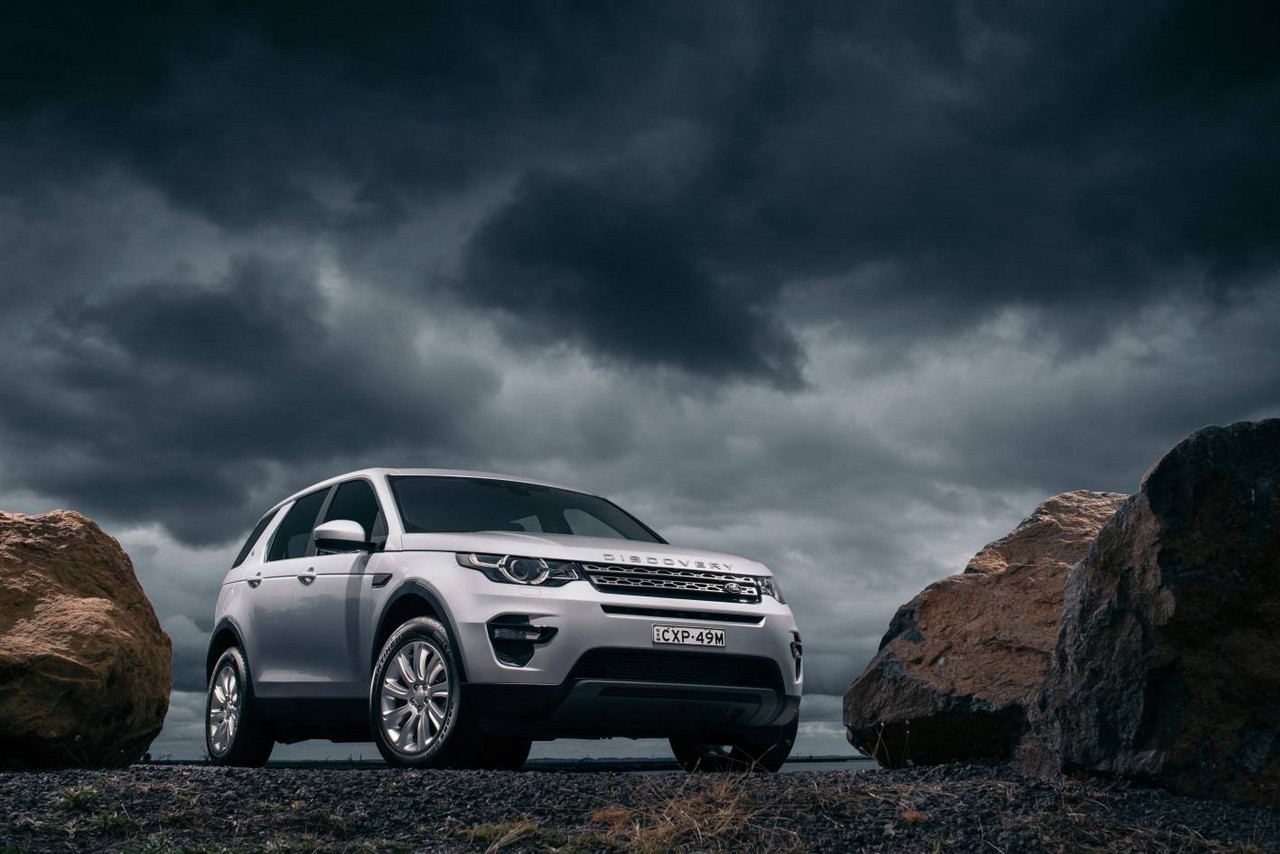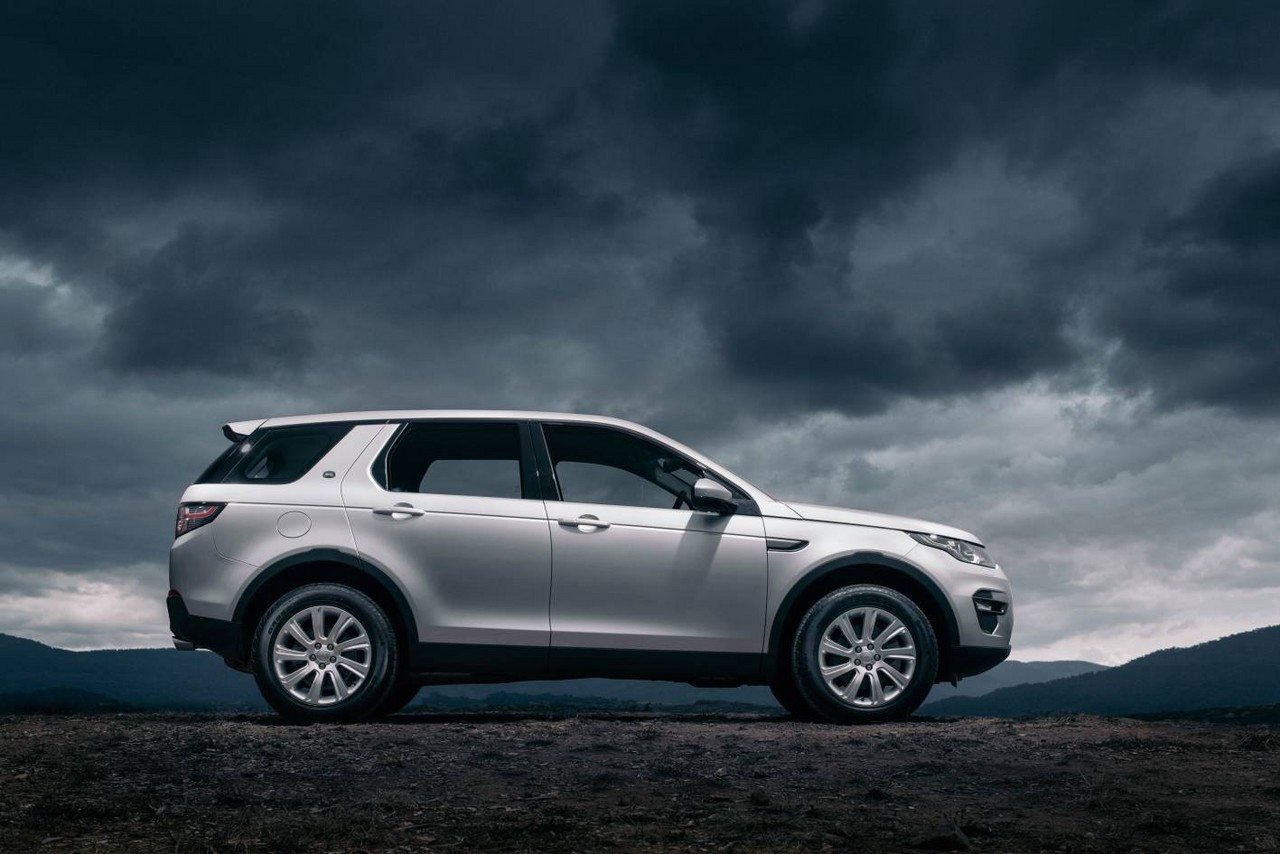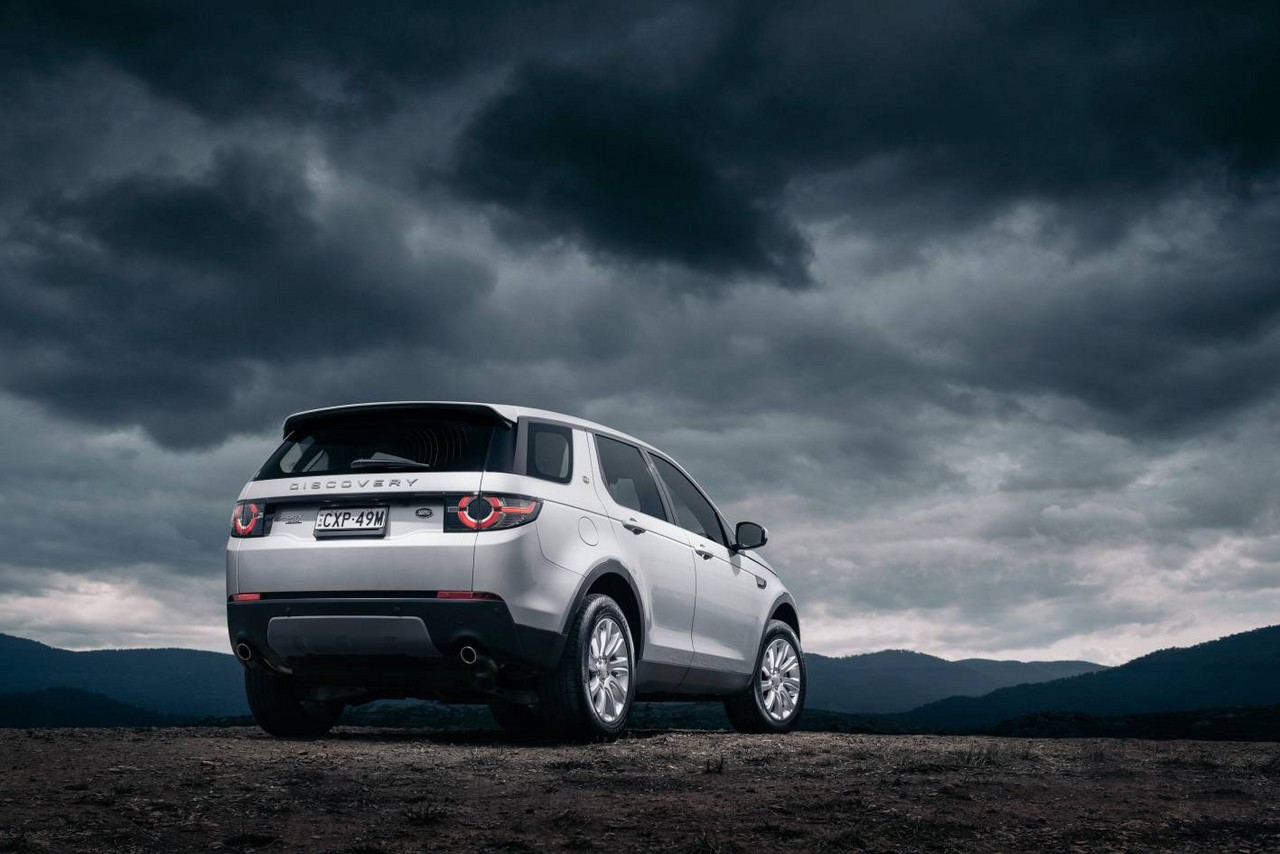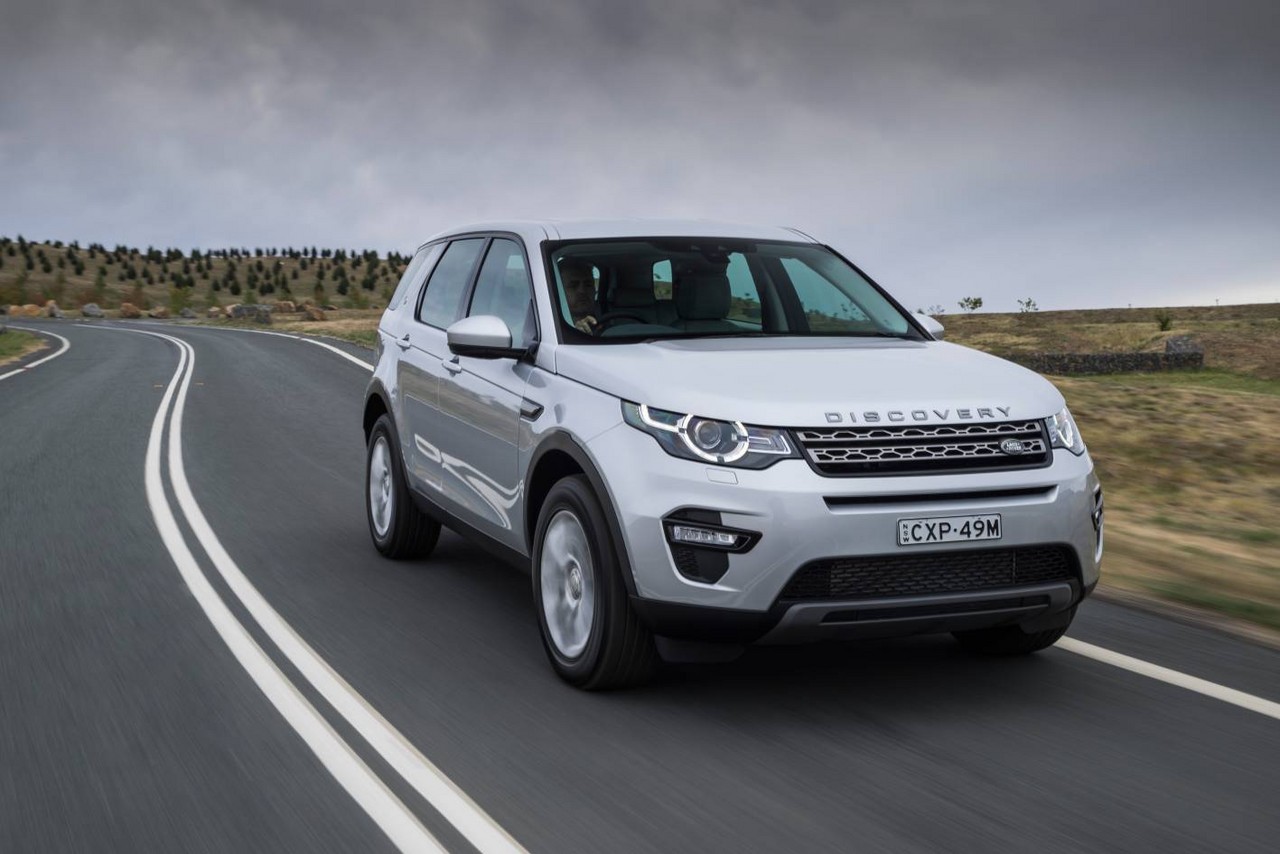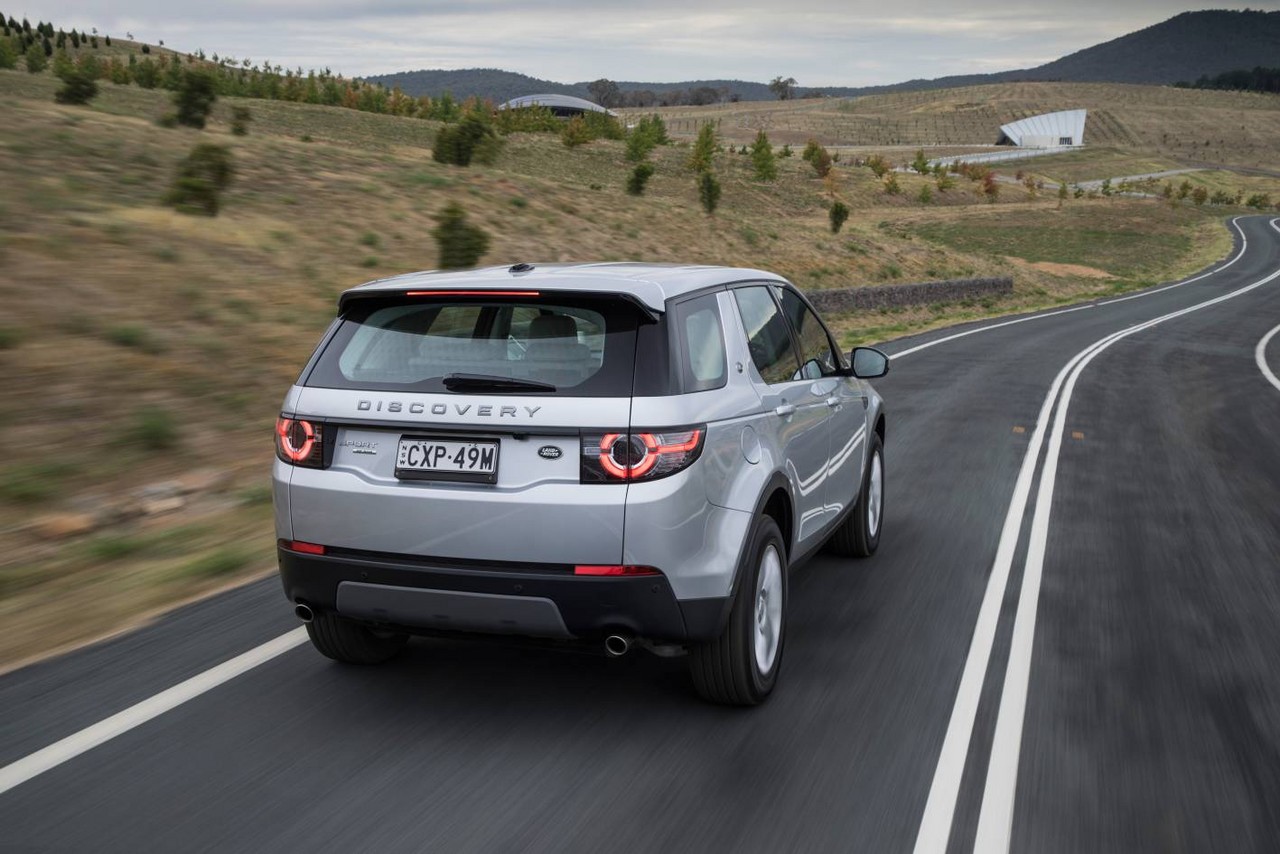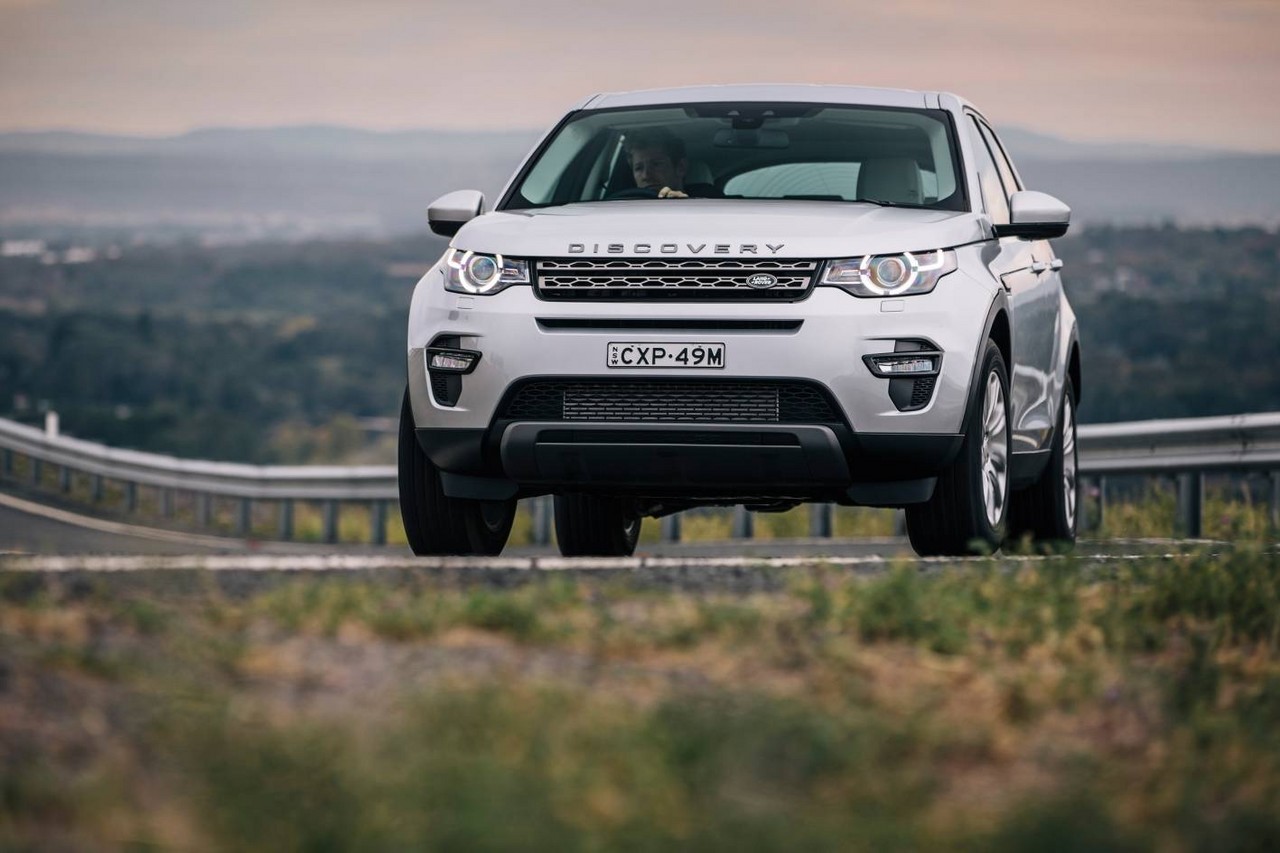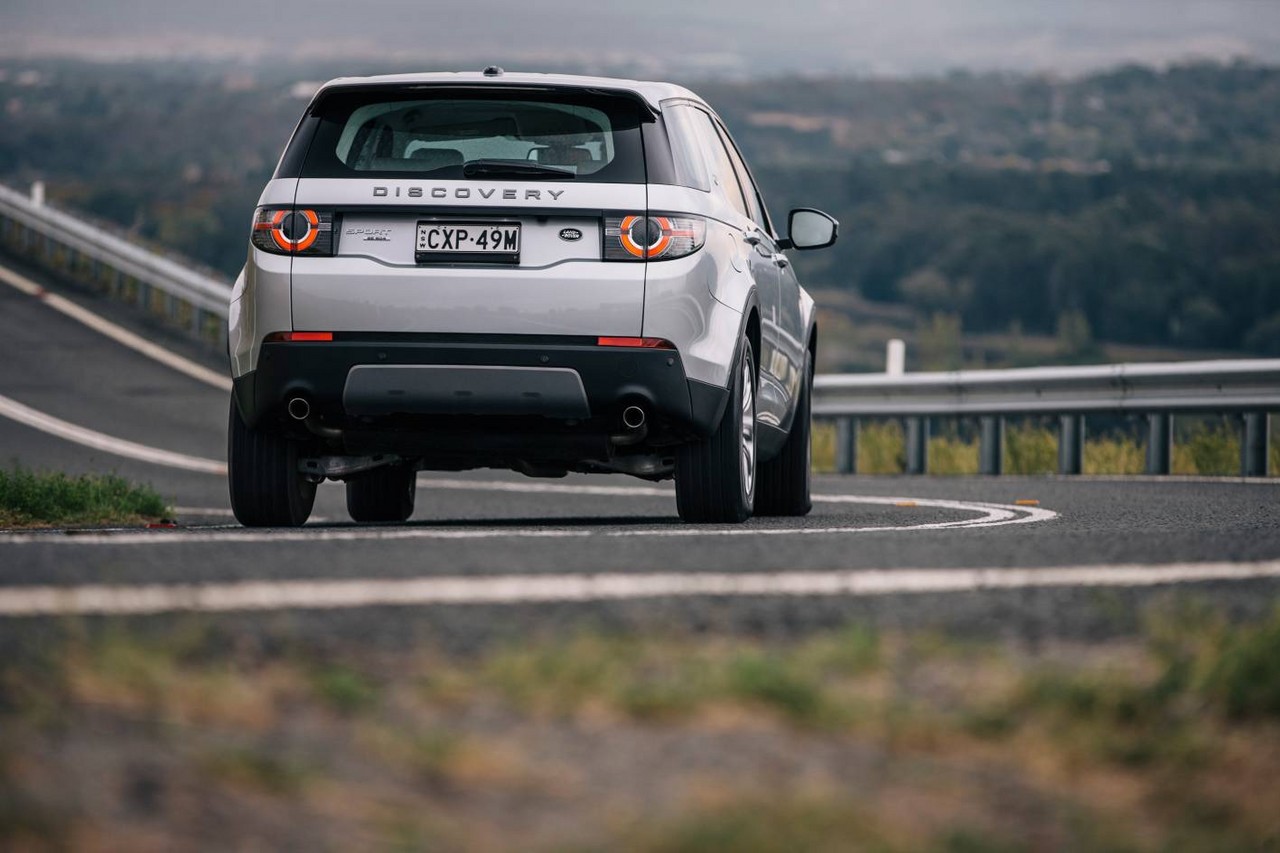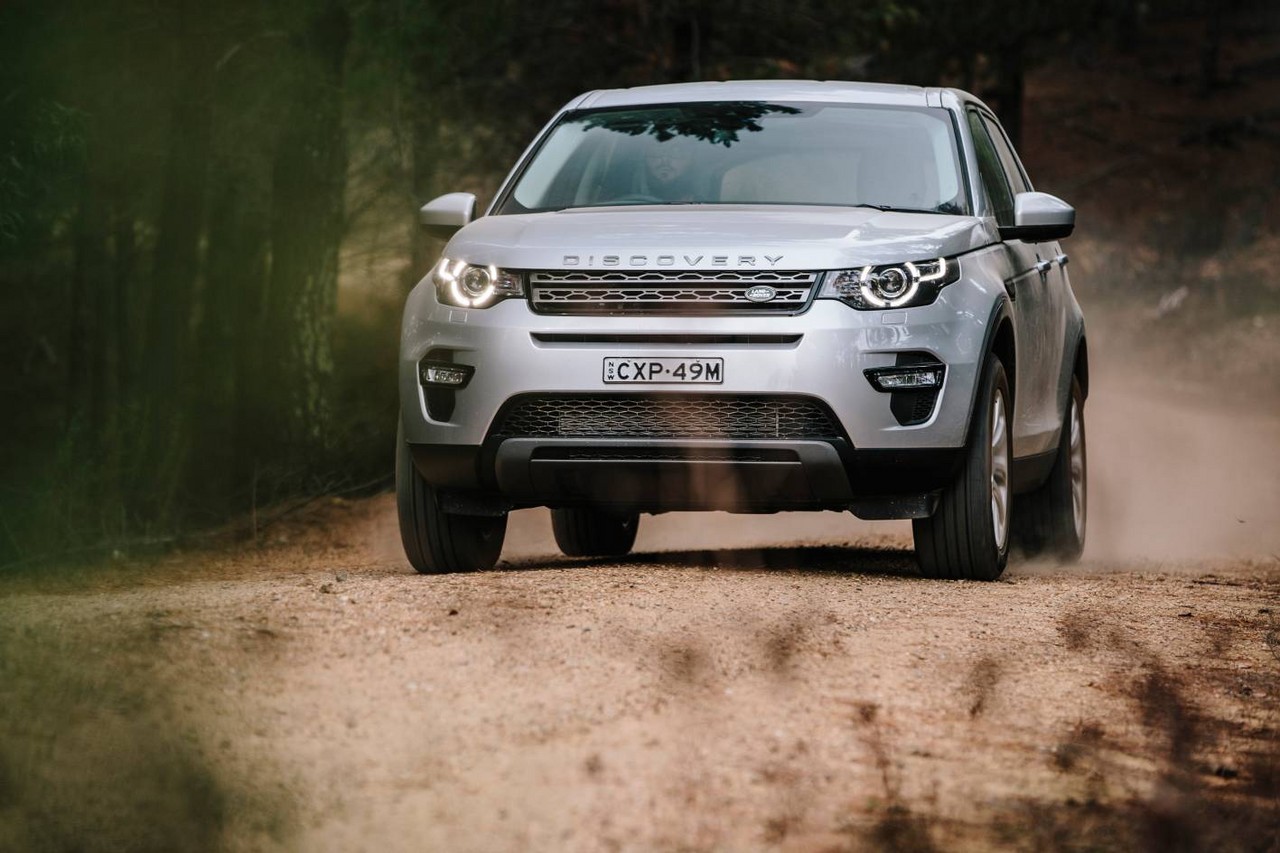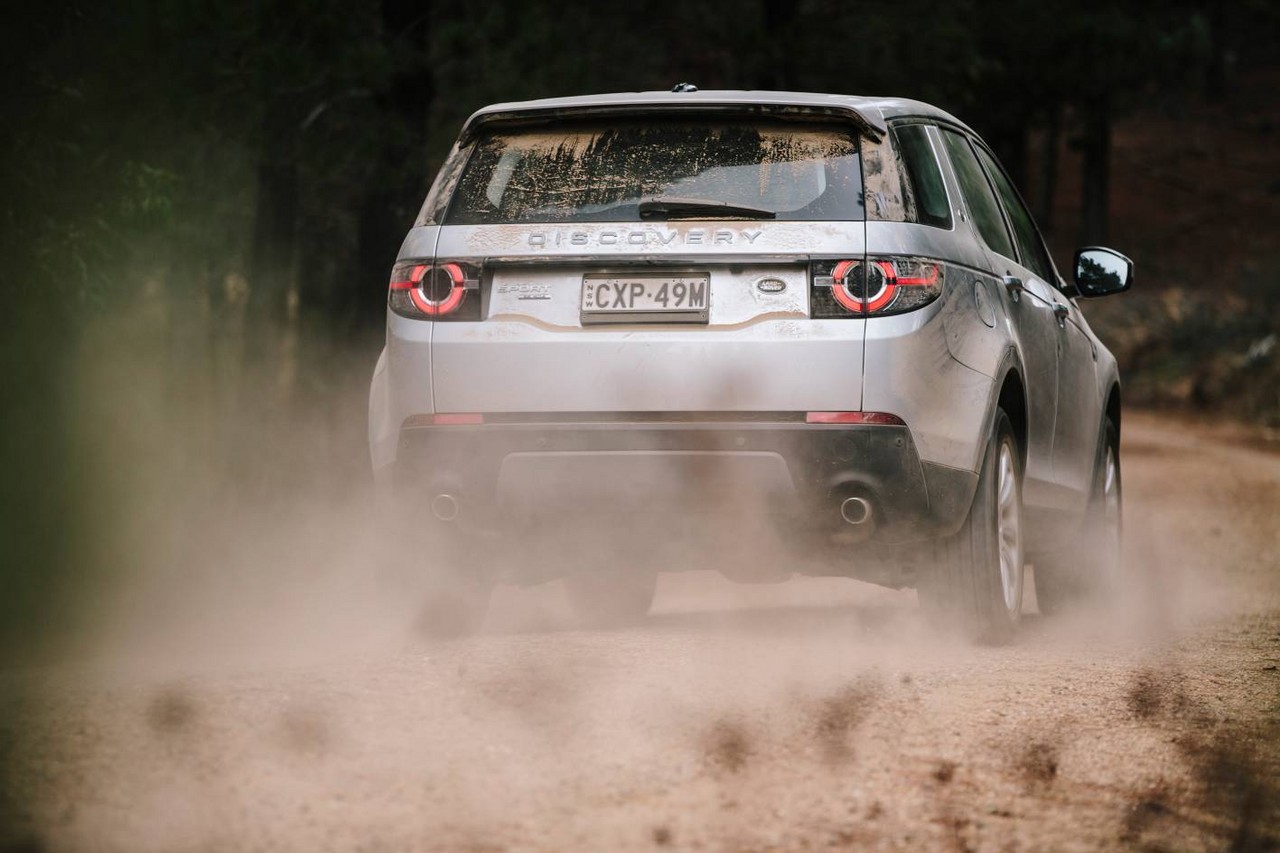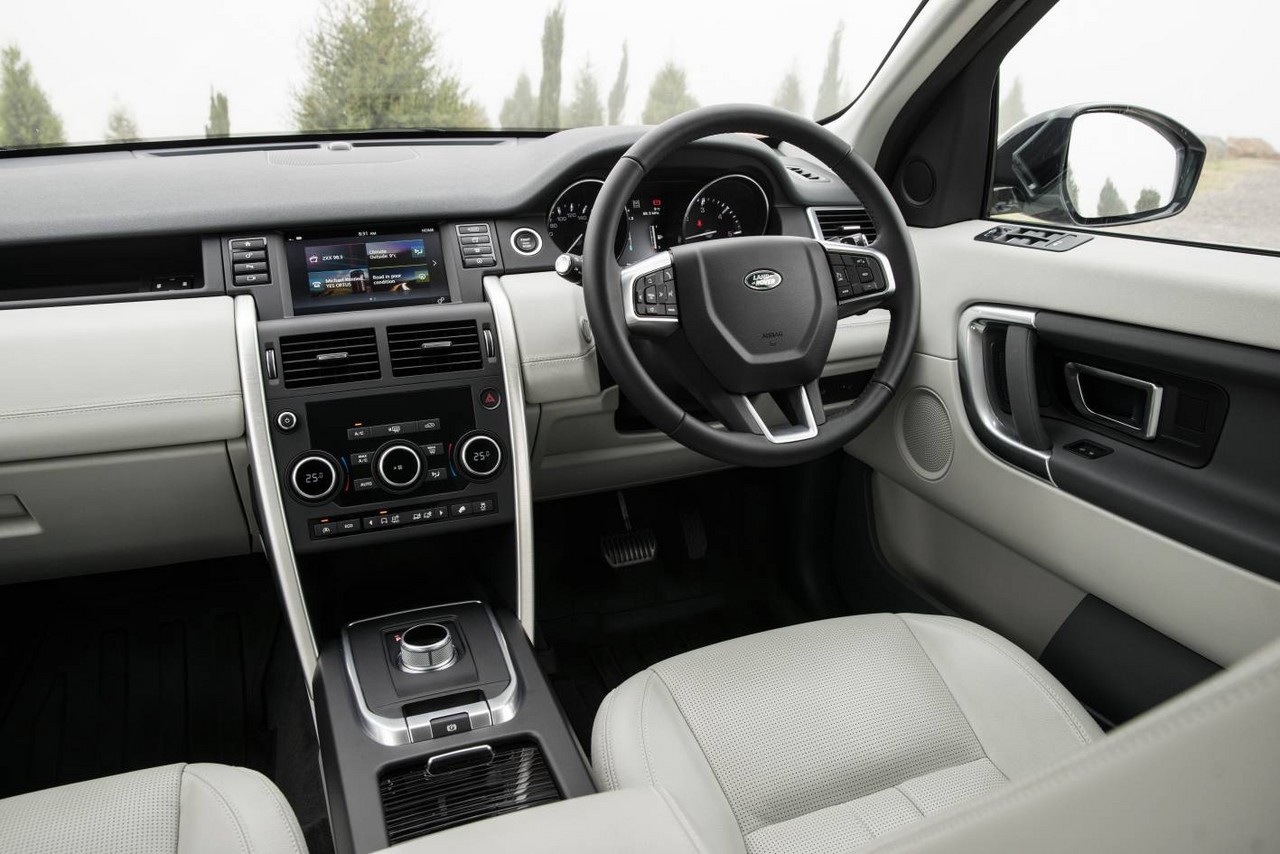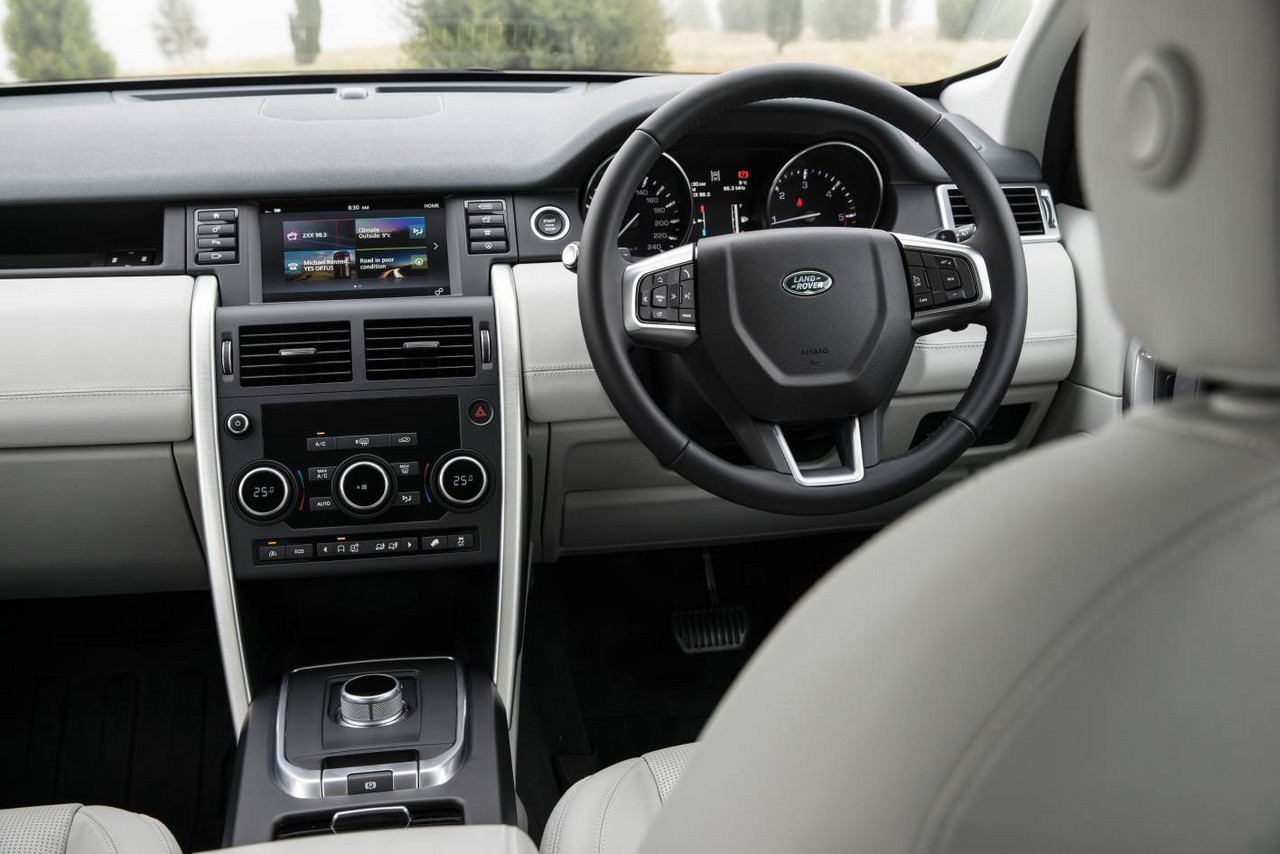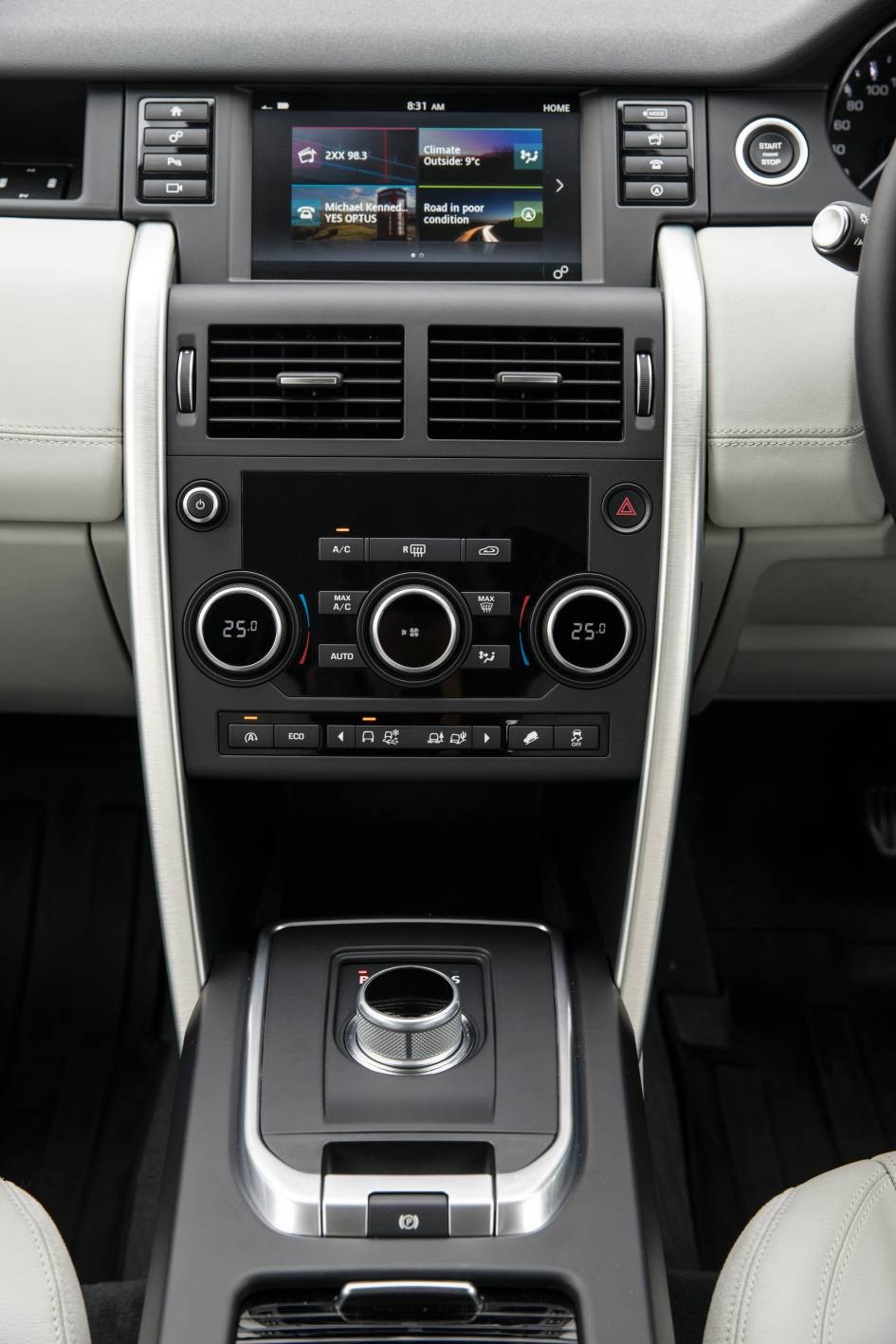
- Spacious and versatile interior
- Off-road capability
- Well-weighted steering
- Generally accomplished ride/handling balance…
- … though suspension lacks low-speed compliance
- Cramped third-row seats
- For turbo-diesel engines, engine noise and vibration
- Some cheap interior materials
Overview
Released in Australia in May 2015, the Land Rover L550 Discovery Sport was a mid-size SUV. Manufactured in Halewood, England, the all-wheel drive L550 Discovery Sport was initially available with 2.2-litre turbo-diesel or 2.0-litre turbocharged petrol engines. In July 2016, however, the 2.2-litre turbo-diesel engines were replaced by 2.0-litre units for the TD4 150 and TD4 180 variants.
While the L550 Discovery Sport had five seats as standard, a third row of seats was available as an extra-cost option.
TD4, SD4 and Si4 engines
Of the engines,
- For the TD4 and SD4 variants, the 2.2-litre ‘Duratorq’ DW12 turbo-diesel engine had a compacted graphite iron (CGI) block, an alloy cylinder head, common-rail injection, piezo-electric injectors, a variable nozzle turbocharger, double overhead camshafts, four valves per cylinder, exhaust gas recirculation and a compression ratio of 15.8:1;
- From July 2016, the TD4 150 and TD4 180 variants were powered by 2.0-litre ‘Ingenium’ diesel engines which had an aluminium alloy cylinder block and head, a single variable geometry turbocharger with variable nozzle turbine technology, a water-cooled intercooler, double overhead camshafts, four valves per cylinder, variable exhaust valve timing, common-rail injection operating at 1800 bar, compression ratios of 15.5:1, exhaust gas recirculation, a selective catalytic reduction (SCR) system and twin counter-rotating balancer shafts. Compared to the 2.2-litre DW12 engines, the Ingenium engines were 24 kilograms lighter; and,
- For the Si4 variant, the 2.0-litre ‘EcoBoost’ turbocharged petrol engine had an aluminium block and cylinder head, direct fuel injection, double overhead camshafts, four valves per cylinder, twin variable valve timing and a compression ratio of 10.0:1.
To minimise fuel consumption, all engines had ‘Stop-Start’ functions that enabled them to shut down when the vehicle is stationary in traffic.
| Years | Edition | Engine | Trans. | Peak power | Peak torque | |
|---|---|---|---|---|---|---|
| TD4 | 2015-16 | SE, HSE |
2.2-litre DW12 turbo-diesel I4 | 6sp man., 6sp auto |
110 kW at 4000 rpm | 420 Nm at 1750 rpm |
| TD4 150 | 2016-on | SE, HSE |
2.0-litre turbo-diesel I4 | 9sp auto | 110 kW at 4000 rpm | 380 Nm at 1750 rpm |
| TD4 180 | 2016-on | SE, HSE, HSE Luxury |
2.0-litre turbo-diesel I4 | 9sp auto | 132 kW at 4000 rpm | 430 Nm at 1750 rpm |
| SD4 | 2015-16 | SE, HSE, HSE Luxury |
2.2-litre DW12 turbo-diesel I4 | 6sp man., 6sp auto |
140 kW at 4000 rpm | 420 Nm at 1750 rpm |
| Si4 | 2015-on | SE | 2.0-litre turbo petrol I4 | 6sp auto | 177 kW at 5500 rpm | 340 Nm at 3200 rpm |
Transmissions
The Discovery Sport was available with nine-speed ZF 9HP48 automatic and six-speed Getrag M66EH50 manual transmissions. Since the L550 Discovery did not have a two-speed transfer case, the first gear for vehicles with the automatic transmission had a low ratio and was only used when needed. In normal conditions, the vehicle would start in second gear.
All-wheel drive systems: Haldex and Land Rover’s ‘Active Driveline’
As standard, the L550 Discovery Sport had a fifth-generation Haldex all-wheel drive system which consisted of an electronically controlled and hydraulically actuated multi-plate clutch. In normal conditions, drive was primarily directed to the front wheels for maximum fuel efficiency. If a loss of traction occurred or was anticipated, the centre coupling would engage to direct torque to the rear wheels (up to a 50:50 front:rear torque split).
As an extra-cost option ($1620 at launch), the Discovery Sport was available with the ‘Land Rover Active Driveline’ which was manufactured by GKN Driveline . Under low loads or when coasting, the Active Driveline system could decouple the rear axle to minimise parasitic losses and improve fuel consumption. Since the Active Driveline disconnected the all-wheel drive components from the gearbox, rather than the central coupling, parasitic losses could be reduced by up to 75 per cent. The Active Driveline system also included a torque vectoring function.
Body and dimensions
While the front architecture of the L550 Discovery Sport was shared with the L538 Range Rover Evoque , the platform was all-new from the B-pillar to the rear. The Discovery Sport’s monocoque utilised high-strength steel, ultra-high-strength boron steel and lightweight aluminium panels; as a result, the Discovery Sport SD4 has a kerb weight of 1817 kg.
The Discovery Sport was 4589 mm long, 2173 mm wide (including mirrors), 1724 mm tall and has a 2741 mm long wheelbase. Furthermore, the Discovery Sport SD4 had a 600 mm wading depth and drag coefficient of 0.366 Cd.
Suspension and steering
The Land Rover Discovery Sport had MacPherson strut front suspension with steel lower control arms, and multi-link rear suspension with a lower control arm. As an extra-option ($1850 at launch), the L550 Discovery Sport SD4 and Si4 were available with electronically-controlled, adjustable dampers (Land Rover’s ‘Adaptive Dynamics’).
The L550 Discovery Sport had variable ratio, electric power-assisted steering (EPAS).
Safety equipment
Standard safety equipment for the Land Rover L550 Discovery Sport included dual front airbags, a driver’s knee airbag, front side airbags, full-length curtain airbags, ABS, electronic brake force distribution, brake assist, electronic stability control, traction control and front seatbelts with pretensioners and load limiters. The Discovery Sport was also fitted with a pedestrian airbag which deployed from the base of the windscreen in the event of a pedestrian collision if it occurred at speeds between 24 and 48 km/h.
As standard, the Discovery Sport had a Lane Departure Warning (LDW) and an Autonomous Emergency Braking (AEB) system which could avoid or mitigate the severity of collisions at speeds below 80 km/h. The AEB system used stereo cameras mounted next to the rear-view mirror to detect potential collision hazards and, if detected, would alert the driver with visual and audible warnings. If the driver failed to respond and a collision was considered unavoidable, an additional warning would be triggered and full braking pressure applied.
Brakes
The L550 Discovery Sport had 325 mm vented front brake discs and 300 mm solid rear discs.
Euro NCAP testing
In Euro NCAP testing , the 2014 Land Rover L550 Discovery Sport TD4 received a five star safety rating which included a 93 per cent adult occupant protection rating and an 83 per cent child occupant protection rating. In the offset crash test, protection of the driver’s head, thighs and feet were rated as good, though chest and lower left leg were rated as adequate (i.e. a slight risk of serious injury); protection of the front passenger was rated as good for all areas. In the side impact test, driver protection was rated as good for all areas. In the more severe pole test, however, protection of the driver’s chest and abdomen were rated as adequate.
Features: Discovery Sport SE
Standard features for the Land Rover Discovery Sport SE included 19-inch alloy wheels, a 190 watt, six-channel sound system with ten speakers, auxiliary inputs (3.5 mm and USB), Bluetooth mobile phone connectivity and audio streaming, SD card-based satellite navigation, an eight-inch colour touchscreen, dual-zone climate control air conditioning, grained leather upholstery, eight-way power adjustable front seats, cruise control with speed limiter, front fog lights, automatic headlights, rain-sensing wipers, daytime running lights (DRL), a rear fog lamp, a rear view camera with reversing guidelines, rear parking sensors, leather-wrapped steering wheel, 60:40 split and folding second row seats, remote central locking, power adjustable and heated door mirrors with folding function, power windows, a height and reach adjustable steering wheel, push-button start, an electrochromatic rear view mirror, illuminated vanity mirrors, phosphorous blue mood lighting, a cargo cover, powered tailgate, two 12 volt power sockets, a trip computer, an alarm and immobiliser.
Features: Discovery Sport HSE
The Discovery Sport HSE was further equipped with an 250 watt, eight-channel sound system with eleven speakers and a subwoofer, ten-way power adjustable front seats, ventilated front seats, air quality sensors for the climate control system, xenon headlights with LED signatures and washers, front parking sensors, door mirrors with memory settings and automatic dipping on reverse, configurable mood lighting and carpet mats.
Features: Discovery Sport HSE Luxury
The range-topping Discovery Sport HSE Luxury was distinguished by its 825 watt, fifteen channel Meridian surround system with 17 speakers, a CD/DVD player, digital audio broadcast (DAB) radio, HDD-based navigation with voice control, Windsor leather upholstery, illuminated aluminium tread plates and premium carpet mats.
Third row seats
The L550 Discovery Sport was available with a third row of seats as an extra-cost option ($1990 at launch). Where fitted, however, the full-size spare wheel was replaced with a space-saver wheel. Furthermore, optional features such as Wade Sensors, a Surround Camera, Adaptive Dynamic dampers, Active Driveline and Blind Spot monitoring were not available where a third row of seats was fitted.
Personalisation options
The L550 Discovery Sport was available with a range of personalisation options, including:
- Black Pack: a gloss-black grille, door mirror caps, front fender vents, hood and tailgate lettering and 19- or 20-inch alloy wheel designs;
- Contrast roof in Santorini Black or Corris Grey that extends to the base of the A-pillars;
- Seven alloy wheel designs – including Aero Viper – with a selection of Silver or Gloss Black finishes;
- Undershields (front and rear) and stainless-steel side steps;
- Noble-silver painted door-mirror caps;
- A dark-tinted panoramic roof with a power-retracting shade; and,
- Luggage compartment rails and a ‘Retention Kit’ (a telescopic crossbeam and retractable band) to secure loose items.
Specifications
- Specifications: Land Rover L550 Discovery Sport (January 2015)
- Specifications: Land Rover L550 Discovery Sport (May 2015)
- Specifications: Land Rover L550 Discovery Sport (July 2016)
Related links
- Brochure: Land Rover L550 Discovery Sport (UK, September 2014)
- Land Rover Australia: Land Rover Discovery Sport
- Wikipedia.org: Land Rover L550 Discovery Sport
